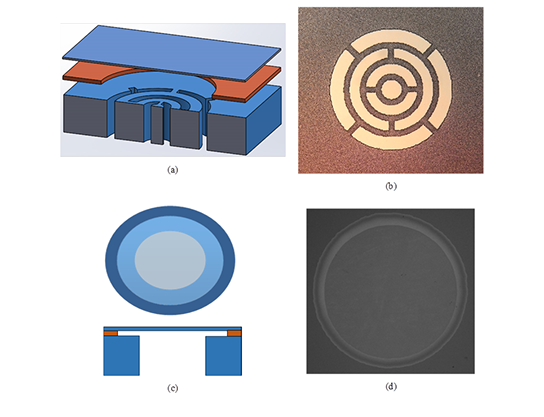
Prof. Rudra Pratap's Research Group

MEMS Microphone and Speakers
The advent of MEMS technology has paved the way for the production of inexpensive and miniature sensors that power consumer electronics. One type of sensor which has benefited from this technology is the MEMS microphone which has been available commercially for over a decade.
The main component in a MEMS microphone is the suspended diaphragm. The deformation of the diaphragm due to incident pressure (sound) waves is sensed either by piezoelectric, piezoresistive, or capacitive means. Our work focuses on the design and fabrication of microphones which use a capacitive sensing mechanism.
Unlike MEMS microphones, MEMS speakers are still making their way into the market. Most of the conventional speakers used in consumer electronic devices are coil-based and, when used in certain devices such as mobile phones, they can consume up to a quarter of the total available energy. Development of MEMS speakers with a high acoustic output and power efficiency is desirable for the rapidly growing MEMS acoustic device market. Although efforts are being made to create piezoelectric- and capacitive-driven microspeakers, they are large (15 mm) compared to other sensors such as microphones, accelerometers, and gyroscopes. As such, there is clearly a need for continued research to develop MEMS speakers which are both efficient and small in size.
Our work aims to develop a MEMS capacitive microphone and MEMS capacitive speaker using a single wafer process. Due to the nature of the sensor, the main challenge in designing these devices is mitigating squeeze film effects.


Deflection Profile
Pressure Profile
COMSOL Simulation results for a uniformly loaded clamped circular diaphragm
Fabrication
In order to construct the device using simple fabrication steps, we start with an SOI wafer. First, we etch openings in the substrate of the wafer which ultimately decide the final dimensions of the diaphragm. We design these openings such that they allow trapped air to easily escape when the device is in operation, thereby eliminating squeeze film effects. We then etch the buried oxide layer to release the structure. The released device layer acts as the diaphragm and the handle layer acts as the rigid backplate of the devices. The transducer is designed such that when used as an actuator it acts as a speaker and when used as a sensor it acts as a microphone. Our initial characterization results suggest that the proposed fabrication process is worth exploring further.

Figure showing (a) exploded view of cross-section of device, (b) the actual microphone after realization, (c) top view and cross section of a speaker (d) the actual speaker after realization
MEMS Lab, Centre for Nano Science and Engineering, Indian Institute of Science. Bangalore-560012
Phone: +91 (80) 2293 3250, +91 (80) 2360 8659 Fax: +91 (80) 2360 1648 Email: pratap@iisc.ac.in, memslab@iisc.ac.in